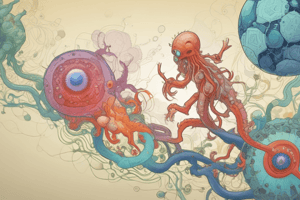Podcast
Questions and Answers
What is defined as the factor that is intentionally varied in an experiment?
What is defined as the factor that is intentionally varied in an experiment?
- Independent variable (correct)
- Dependent variable
- Control group
- Constant
Which of the following describes a characteristic of a high standard deviation?
Which of the following describes a characteristic of a high standard deviation?
- All data points are identical
- Data points coincide with the expected value
- Data points are spread out from the mean (correct)
- Data points are clustered close to the mean
Which percentage of data typically falls within 2 standard deviations of the mean in a normal distribution?
Which percentage of data typically falls within 2 standard deviations of the mean in a normal distribution?
- 95% (correct)
- 50%
- 67%
- 99%
What is an example of qualitative data?
What is an example of qualitative data?
Which statement accurately describes the role of hydrogen bonds in DNA?
Which statement accurately describes the role of hydrogen bonds in DNA?
Which type of bond is formed between atoms that share electrons unequally, resulting in dipole moments?
Which type of bond is formed between atoms that share electrons unequally, resulting in dipole moments?
What is the main difference between competitive and noncompetitive inhibitors?
What is the main difference between competitive and noncompetitive inhibitors?
What is one major structural difference between ribose and deoxyribose?
What is one major structural difference between ribose and deoxyribose?
Which of the following statements about enzyme functionality is inaccurate?
Which of the following statements about enzyme functionality is inaccurate?
What is the primary role of the rough endoplasmic reticulum (Rough ER) in a eukaryotic cell?
What is the primary role of the rough endoplasmic reticulum (Rough ER) in a eukaryotic cell?
Which of the following best describes hypertonic solutions in relation to animal cells?
Which of the following best describes hypertonic solutions in relation to animal cells?
What process involves the active transport of sodium and potassium ions across the plasma membrane?
What process involves the active transport of sodium and potassium ions across the plasma membrane?
Which of the following accurately describes the relationship between a cell's surface area and its volume for efficient transport?
Which of the following accurately describes the relationship between a cell's surface area and its volume for efficient transport?
During photosynthesis, what role does chlorophyll play in the process?
During photosynthesis, what role does chlorophyll play in the process?
What is the main difference between phagocytosis and pinocytosis?
What is the main difference between phagocytosis and pinocytosis?
Which type of transport requires energy to move substances against their concentration gradient?
Which type of transport requires energy to move substances against their concentration gradient?
What happens to plant cells when placed in a hypotonic solution?
What happens to plant cells when placed in a hypotonic solution?
Which of the following accurately describes cellular respiration?
Which of the following accurately describes cellular respiration?
Flashcards
Independent Variable
Independent Variable
The variable that is changed or manipulated by the experimenter.
Dependent Variable
Dependent Variable
The variable that is measured or observed in response to changes in the independent variable.
Control Group
Control Group
A group in an experiment that does not receive the treatment or the change in the independent variable. It serves as a baseline for comparison.
Null Hypothesis
Null Hypothesis
Signup and view all the flashcards
Constant
Constant
Signup and view all the flashcards
Standard Deviation
Standard Deviation
Signup and view all the flashcards
Standard Error of Mean
Standard Error of Mean
Signup and view all the flashcards
Qualitative data
Qualitative data
Signup and view all the flashcards
Quantitative data
Quantitative data
Signup and view all the flashcards
Deductive reasoning
Deductive reasoning
Signup and view all the flashcards
What part of the cell membrane is responsible for selectivity?
What part of the cell membrane is responsible for selectivity?
Signup and view all the flashcards
Responsible for cell-to-cell recognition?
Responsible for cell-to-cell recognition?
Signup and view all the flashcards
Describe the relationship between the volume of a cell and its surface area.
Describe the relationship between the volume of a cell and its surface area.
Signup and view all the flashcards
What ratio is the most efficient for transport?
What ratio is the most efficient for transport?
Signup and view all the flashcards
Describe the following solution: ISOTONIC
Describe the following solution: ISOTONIC
Signup and view all the flashcards
Describe the following solution: HYPERTONIC
Describe the following solution: HYPERTONIC
Signup and view all the flashcards
Describe the following solution: HYPOTONIC
Describe the following solution: HYPOTONIC
Signup and view all the flashcards
Describe the following transport system: SIMPLE DIFFUSION
Describe the following transport system: SIMPLE DIFFUSION
Signup and view all the flashcards
Describe the following transport system: FACILITATED DIFFUSION
Describe the following transport system: FACILITATED DIFFUSION
Signup and view all the flashcards
Describe the following transport system: ACTIVE TRANSPORT
Describe the following transport system: ACTIVE TRANSPORT
Signup and view all the flashcards
Study Notes
IB Biology SL 1 - Fall 2024 Final Exam Review
-
Independent Variable: The variable that is manipulated or changed by the researcher.
-
Dependent Variable: The variable that is measured or observed.
-
Control Group: The group that does not receive the treatment or manipulation. Used for comparison.
-
Null Hypothesis: A statement that there is no significant difference or relationship between variables.
-
Constant: A factor that is kept the same throughout the experiment.
-
Standard Deviation: A measure of the amount of variability or spread of data around the mean.
- Low standard deviation: Indicates that the data points are clustered close to the mean. A consistent result implies the experiment is reliable.
- High standard deviation: Indicates that the data points are spread out far from the mean. The experiment's result is less reliable due to inconsistency.
-
Standard Error of the Mean (SEM): A measure of the variability of the sample mean. Indicates the precision in measuring the mean.
- Low SEM: Data points are tightly clustered around the sample mean. Indicates higher precision.
- High SEM: Data points are widely spread around the sample mean. Suggests less precision or more variability in the experiment.
- Overlapping error bars: Suggest that the observed difference might not be statistically significant.
- Non-overlapping error bars: Suggests a statistically significant difference between the means.
-
Qualitative Data: Descriptive data, often involving categories or qualities.
- Examples: Color, texture, shape, presence/absence of a characteristic.
-
Quantitative Data: Numerical data.
- Examples: Temperature, mass, height, counts, measurements.
-
Deductive Reasoning: Starts with a general theory and predicts specific outcomes.
-
Inductive Reasoning: Starts with specific observations and forms general conclusions.
-
Major Functional Groups: Hydroxyl, Carbonyl, Carboxyl, Amino, Phosphate, Sulfhydryl.
-
Deoxyribose vs. Ribose: Deoxyribose lacks an oxygen atom on the 2' carbon. Key difference.
-
Base Pairing in DNA: Adenine (A) pairs with Thymine (T), and Guanine (G) pairs with Cytosine (C). Complementary base pairs.
-
Molecular Structures: Draw and label the structures to learn how to identify these molecules yourself.
-
Saturated vs. Unsaturated Fats: Saturated fats have no double bonds between carbon atoms; unsaturated fats have one or more double bonds.
-
Primary Structure of Proteins: Influences the higher structures (secondary, tertiary, and quaternary) and, subsequently, the protein's function.
-
Bonds Between DNA Base Pairs: Hydrogen bonds.
- A-T: 2 hydrogen bonds.
- G-C: 3 hydrogen bonds.
- G-C bonds: Stronger than A-T bonds.
-
Functions of Biological Molecules:
- Carbohydrates: Energy source, structure (e.g., cellulose).
- Lipids: Energy storage, insulation, cell membrane structure.
- Proteins: Enzymes, structure (e.g., keratin), transport, defense.
- Nucleic Acids: Genetic information storage.
-
Enzyme Factors Affecting Rate: Temperature, pH, substrate concentration, enzyme concentration.
- Temperature: Optimal temperature. Denaturation is an extreme case.
- pH: Optimal pH. Denaturation occurs at extreme values.
-
Chemical Bonds: Define and distinguish these.
-
Water Properties: Cohesion, adhesion, high specific heat, high heat of vaporization, universal solvent, less dense as a solid.
-
Competitive vs. Noncompetitive Inhibitors: Competitive inhibitors compete with the substrate for the active site; noncompetitive inhibitors bind to a different site, changing the enzyme's shape.
-
Hydrolysis & Dehydration Synthesis: Hydrolysis breaks down molecules by adding water; dehydration synthesis forms molecules by removing water.
-
Protein Synthesis Organelles: Ribosomes, Rough ER.
-
Compartmentalization: Organelles in eukaryotic cells isolate chemical reactions to maintain optimal processes.
-
Plant vs. Animal Cells: Similarities and differences in structure (organelles present) and function.
-
Prokaryotic vs. Eukaryotic Cells: Similarities and differences in structure (organelle types).
-
Organelle Functions: Describe each organelle's function.
-
Cell Membrane: Selectivity and recognition are related properties that control what comes in and out of a cell.
-
Cell Volume & Surface Area: Small surface area to volume ratio limits transport.
-
Solutions: Isotonic, hypertonic, and hypotonic solutions.
-
Transport Systems: Simple diffusion, facilitated diffusion, active transport.
- Simple diffusion: Molecules move passively down their concentration gradient.
- Facilitated diffusion: Molecules move across membrane with the help of carrier proteins.
- Active transport: Molecules move against their concentration gradient. Requires energy.
-
Plasma Membrane Permeability: Lipid-soluble molecules can easily pass through.
-
Sodium-Potassium Pumps: Active transport system that maintains ion gradients across the cell membrane
-
Cotransport: One substance moves down its gradient, providing energy for another substance to move up its gradient.
-
ATP in Active Transport: Provides energy to power the movement of molecules.
-
Animal Cell Processes: Lysis, crenation
-
Plant Cell Processes: Plasmolysis, turgor pressure.
-
Endocytosis & Exocytosis: Endocytosis is the uptake of a substance; Exocytosis is the release of a substance.
-
Plant pH Changes: Decreasing pH is harmful to plants.
-
Catabolism & Anabolism: Catabolism breaks down molecules; anabolism builds them up.
-
Osmosis & Aquaporins: Aquaporins increase water transport.
-
Cell Membrane Structure & Label: Include a labeled diagram.
-
Factors Affecting Diffusion Rate: Concentration gradient, temperature, size of molecules, surface area.
-
Photosynthesis & Cellular Respiration Equations: Write and label each.
-
Cellular Respiration Steps: Glycolysis, Krebs cycle, electron transport chain, products.
-
Sunlight's Role in Photosynthesis: Sunlight provides the energy for the process.
-
Fermentation Processes: Lactic acid fermentation, alcohol fermentation.
-
Chlorophyll (a & b): Explain the roles of each kind of chlorophyll in energy absorption in photosynthesis.
Studying That Suits You
Use AI to generate personalized quizzes and flashcards to suit your learning preferences.




